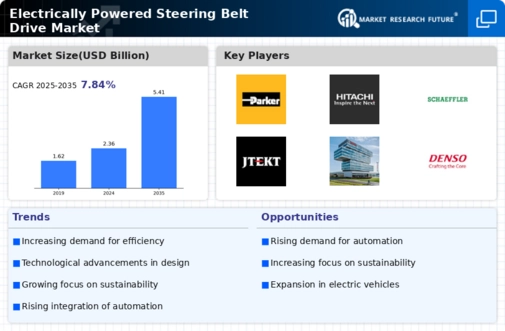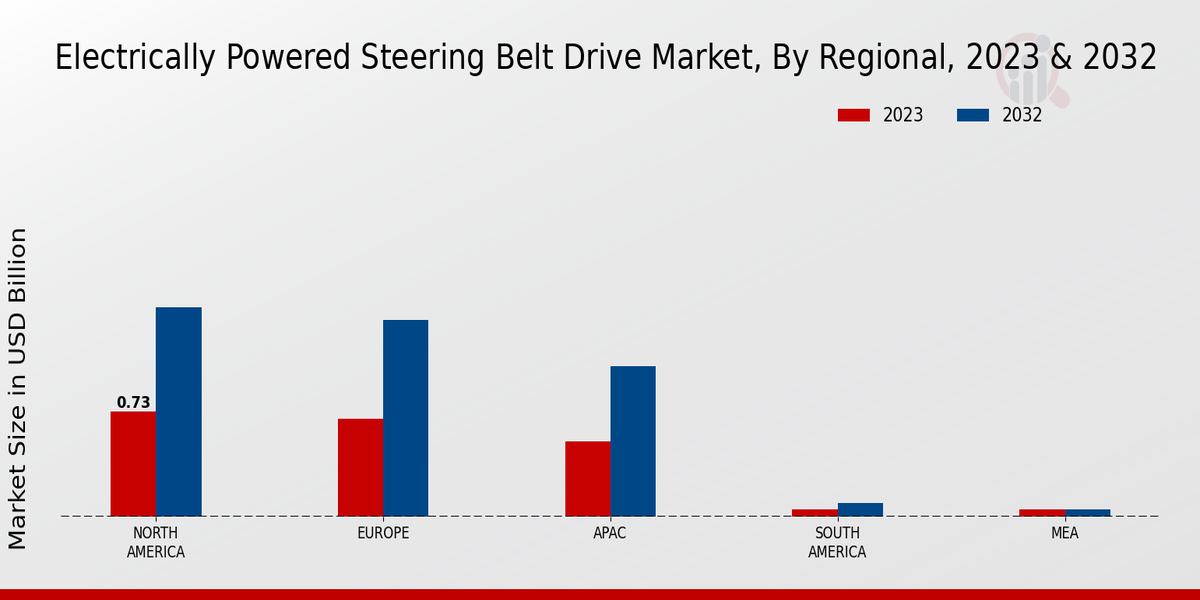Growing Demand for Fuel Efficiency
The Global Electrically Powered Steering Belt Drive Market Industry is experiencing a surge in demand for fuel-efficient vehicles. As consumers become increasingly environmentally conscious, automakers are compelled to adopt technologies that enhance fuel economy. Electrically powered steering systems contribute to this goal by reducing the overall weight of vehicles and improving energy efficiency. In 2024, the market is projected to reach 2.36 USD Billion, reflecting a growing preference for electric power steering systems. This trend is expected to continue, with the market anticipated to expand to 5.41 USD Billion by 2035, indicating a compound annual growth rate of 7.84% from 2025 to 2035.
Rising Production of Electric Vehicles
The rising production of electric vehicles (EVs) is a significant factor propelling the Global Electrically Powered Steering Belt Drive Market Industry. As global automotive manufacturers ramp up their EV production to meet growing consumer demand, the need for efficient steering solutions becomes paramount. Electrically powered steering systems are integral to the design of EVs, providing the necessary responsiveness and efficiency. This trend is expected to continue, with the market projected to grow substantially in the coming years. The increasing focus on sustainability and the transition towards electric mobility are likely to further enhance the market's growth trajectory.
Regulatory Support for Electric Vehicles
Government regulations promoting electric vehicles are significantly influencing the Global Electrically Powered Steering Belt Drive Market Industry. Many countries are implementing stringent emission standards and providing incentives for electric vehicle adoption. These regulatory frameworks encourage automakers to incorporate electrically powered steering systems, which are essential for the efficient operation of electric vehicles. As a result, the market is poised for growth as manufacturers align their product offerings with regulatory requirements. This alignment not only fosters innovation but also enhances the overall market landscape, making it more conducive for the proliferation of electric steering technologies.
Technological Advancements in Steering Systems
Technological innovations play a pivotal role in shaping the Global Electrically Powered Steering Belt Drive Market Industry. The integration of advanced sensors and control systems enhances the performance and responsiveness of electrically powered steering systems. These advancements not only improve driving comfort but also contribute to vehicle safety by providing better handling and stability. As manufacturers invest in research and development, the market is likely to witness the introduction of more sophisticated steering solutions. This trend aligns with the increasing consumer expectations for enhanced driving experiences, further driving the growth of the market.
Consumer Preference for Advanced Driver Assistance Systems
The increasing consumer preference for advanced driver assistance systems (ADAS) is a key driver of the Global Electrically Powered Steering Belt Drive Market Industry. ADAS technologies, which often rely on electrically powered steering systems, enhance vehicle safety and convenience. Features such as lane-keeping assistance and adaptive cruise control are becoming standard in modern vehicles, driving demand for more sophisticated steering solutions. As automakers strive to meet consumer expectations for safety and convenience, the integration of electrically powered steering systems becomes essential. This trend is expected to propel market growth as consumers prioritize vehicles equipped with these advanced features.























Leave a Comment